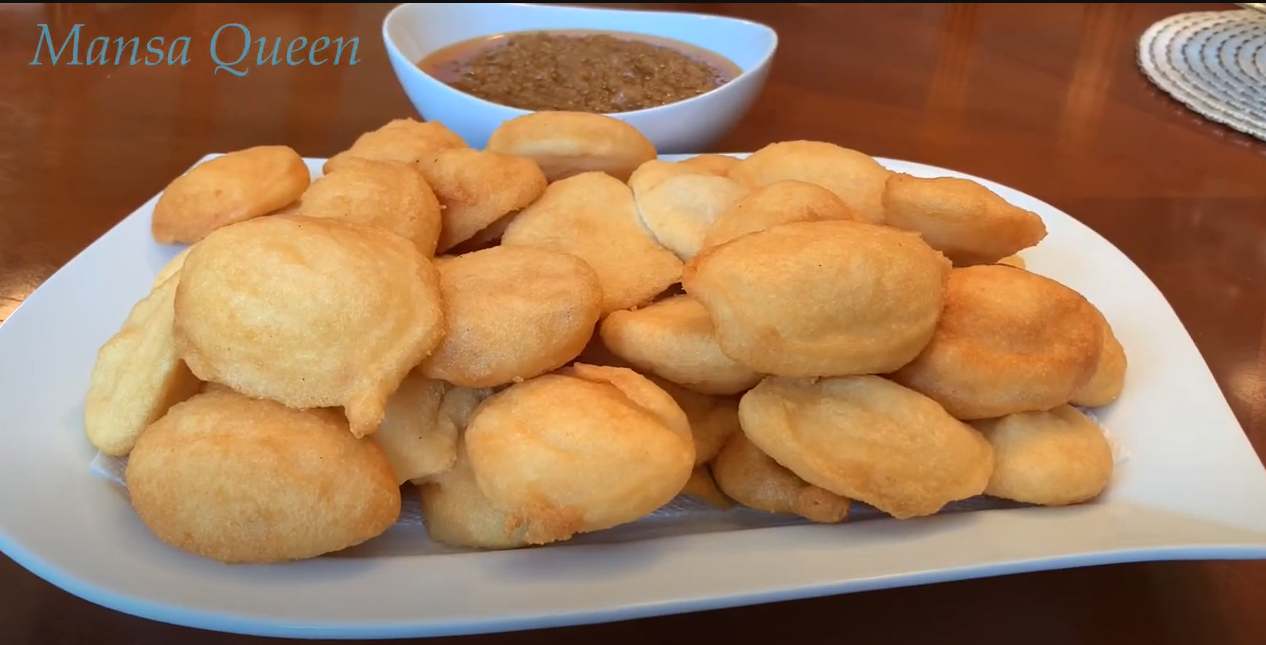Akara, also called bean cakes, is a favourite side dish for breakfast in most West African countries. All you need are black-eyed beans, salt, pepper, and oil to fry.
You can opt to eat it with any bread of your choice or with porridge.
Become an insider. Subscribe to our newsletter for more top trending stories like this!
People Also Read: Recipe: Making Arroz Doce of Sao Tome & Principe
How to Prepare Akara
Ingredients
- Spices
- 3 Cups of oil
- ¼ tbsp. of salt
- 1 onion. Minced
- ¼ tbsp of paprika
- 4 red onions, cubed
- 2 habanero peppers
- A loaf of brown bread.
- 3 cups of black-eyed peas
Instructions
- Wash the beans thoroughly or soak them for 5-6 hours to soften. Ideally, soak them overnight if you want to get the most results.
- Pour the soaking water away and peel it. You can do this by pouring it into the blender and then adding a lot of water. Pulse the beans in the blender for a few seconds to peel them. Pouring enough water on it in the blender ensures only the peels come off.
- Strain the mixer to separate the beans from the peel.
- Blend the beans back into the blender and blend. Add a little water to ensure consistency.
- Pour it into a bowl and add salt, minced onions, and powdered pepper.
- At this point, you can’t fry the akara, but you can mix it until it’s fluffy. You can use a cake mixer to mix the akara beans until they’re fluffy. You can also use a hand mixer if the amount is small.
- Pour the rest of the oil into the fryer on high heat. Scoop tablespoons full of akara into the hot oil to fry. Use a khebab or bamboo dining stick to turn the akara to the other side.
- Continue to turn over until both sides are brown.
- Transfer the fried akara from the hot oil onto a paper towel laid on a plate. This process soaks up excess oil.
- Scoop more tablespoons of the fluffy mixture into the hot oil until you fry all the akara.
- Spread a tablespoon of the akara source into a slice of bread and add two or three akara. Add one slice of bread to the first to make an akara sandwich. Enjoy!
Steps for Preparing Akara Sauce
- Transfer the cubed onions to the blender and add the habanero peppers. Pulse them to obtain a rough consistency.
- Boil the blended onions in a dry pan to get rid of the excess water. Add ¼ cup of oil to the onions and stir. Add a little salt and spice.
- Add paprika and stir. You can add some powdered pepper to give the sauce color and a spicy feel.
- Cook on low heat for 5 minutes and set aside.
Tips for Making Akara
- Ensure to soak the beans overnight to make them soft enough for the peels to come out.
- After blending the skinless beans, mix them until they’re fluffy before you fry them.
- Allow the oil to heat well before frying the akara to avoid soaking up the oil.
- You can add enough pepper to the akara to make it spicy.
- Also, you can roughly pulse the minced onions to add to the mixture before frying.
- Always lay enough paper towels, so soak the oil in the akara.
- You can add one or two eggs to the mixture.
- Eat them while it’s hot.
People Also Read: Recipe: Nsima–The Heart and Soul of Malawian Cuisine
Video Credit: Mansa Queen
Queen shares food and drink recipes as well as cooking hacks. She cooks most of her food from scratch, but she also recognizes that life happens, and sometimes we just need something quick and easy!
Become an insider. Subscribe to our newsletter for more top trending stories like this!

Gambian Akara
Equipment
Ingredients
- Spices
- 3 Cups of oil
- ¼ tbsp. of salt
- 1 onion. Minced
- ¼ tbsp of paprika
- 4 red onions cubed
- 2 habanero peppers
- A loaf of brown bread.
- 3 cups of black-eyed peas
Instructions
- Wash the beans thoroughly or soak them for 5-6 hours to soften. Ideally, soak them overnight if you want to get the most results.
- Pour the soaking water away and peel it. You can do this by pouring it into the blender and then adding a lot of water. Pulse the beans in the blender for a few seconds to peel them. Pouring enough water on it in the blender ensures only the peels come off.
- Strain the mixer to separate the beans from the peel.
- Blend the beans back into the blender and blend. Add a little water to ensure consistency.
- Pour it into a bowl and add salt, minced onions, and powdered pepper.
- At this point, you can’t fry the akara, but you can mix it until it’s fluffy. You can use a cake mixer to mix the akara beans until they’re fluffy. You can also use a hand mixer if the amount is small.
- Pour the rest of the oil into the fryer on high heat. Scoop tablespoons full of akara into the hot oil to fry. Use a khebab or bamboo dining stick to turn the akara to the other side.
- Continue to turn over until both sides are brown.
- Transfer the fried akara from the hot oil onto a paper towel laid on a plate. This process soaks up excess oil.
- Scoop more tablespoons of the fluffy mixture into the hot oil until you fry all the akara.
- Spread a tablespoon of the akara source into a slice of bread and add two or three akara. Add one slice of bread to the first to make an akara sandwich. Enjoy!
Video
Nutrition

Interested in watching the full article video? See below. Subscribe to our YouTube channel for more original, inspiring videos on the black experiences.
Nearly 80% of consumers visit directories with reviews to find a local business. List your business for free in our exclusive Spotcovery Black-Owned Business Directory.
Spotcovery offers unique and fresh daily content on Black culture, lifestyle, and experiences. We talk about everything black, black people, black-owned and black-owned businesses. We also deliver authentic and relevant content that will inform, inspire, and empower you! The future of black media is critical to today’s black experience! Our primary audience includes African Americans, Africans, Afro-Caribbeans, and people of African heritage. Black culture is for the culture!
Become an insider. Subscribe to our newsletter for more top trending stories like this!





